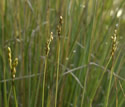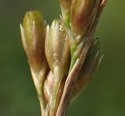Juncus vaseyi (Vasey's Rush)
| Also known as: | |
|---|---|
| Genus: | Juncus |
| Family: | Juncaceae (Rush) |
| Life cycle: | perennial |
| Origin: | native |
| Habitat: | sun; moist sandy soil; fens, sedge meadows, prairies, ditches, shores |
| Fruiting season: | June - August |
| Plant height: | 8 to 28 inches |
| Wetland Indicator Status: | GP: FACW MW: FACW NCNE: FACW |
| MN county distribution (click map to enlarge): |  |
| National distribution (click map to enlarge): |  |
Pick an image for a larger view. See the glossary for icon descriptions.
Detailed Information
Flower: 

![[photo of clusters]](/udata/r9ndp23q/grass/juncus-vaseyi_0709_094956-t.jpg) Branching clusters at the top of the stem, the branches erect with 5 to 15(30) flowers, usually crowded, sometimes loose. The lowest branch is subtended by an erect, leaf-like bract that usually rises above the uppermost branch. Flowers are single, not in heads of 2 or more, stalkless or nearly so, with 6 tepals (petals and similar sepals) in 2 layers, 3.3 to 4.6 mm long, pointed at the tip, green with pale papery edging, and the inner tepals as long as or slightly shorter than the outer. Flowers have a 3-parted style and 6 stamens, the anthers (tips) about as long as the filament (stalk).
Branching clusters at the top of the stem, the branches erect with 5 to 15(30) flowers, usually crowded, sometimes loose. The lowest branch is subtended by an erect, leaf-like bract that usually rises above the uppermost branch. Flowers are single, not in heads of 2 or more, stalkless or nearly so, with 6 tepals (petals and similar sepals) in 2 layers, 3.3 to 4.6 mm long, pointed at the tip, green with pale papery edging, and the inner tepals as long as or slightly shorter than the outer. Flowers have a 3-parted style and 6 stamens, the anthers (tips) about as long as the filament (stalk).
Leaves and stems: 

![[photo of auricle]](/udata/r9ndp23q/grass/juncus-vaseyi_0703_130358-t.jpg) A flowering stem has 1 to 3 alternate leaves near the base of the stem. Leaves are 4 to 12 inches long, up to 1mm wide, about half as long as the flowering stem or less, round in cross-section. The sheath is open at the front. At the tip of the sheath is an obscure pair of rounded lobes (auricles) .2 to .4 mm long, thin and papery. Stems are round in cross-section, smooth, erect, unbranched, multiple from the base and creating tight clumps from short rhizomes.
A flowering stem has 1 to 3 alternate leaves near the base of the stem. Leaves are 4 to 12 inches long, up to 1mm wide, about half as long as the flowering stem or less, round in cross-section. The sheath is open at the front. At the tip of the sheath is an obscure pair of rounded lobes (auricles) .2 to .4 mm long, thin and papery. Stems are round in cross-section, smooth, erect, unbranched, multiple from the base and creating tight clumps from short rhizomes.
Fruit: 
![[photo of fruit]](/udata/r9ndp23q/grass/juncus-vaseyi-2-t.jpg) The tepals persist and become brown and are mostly appressed in fruit. Fruit is an oblong-elliptic, 3-chambered capsule 3.8 to 4.7 mm long, greenish brown to golden brown when mature, flat across the top, as long as or longer than the tepals. Inside the capsule are numerous tiny seeds, oblong-elliptic, the body .5 to .7mm long, amber colored to brown when mature with a white appendage (tail) at each end, each half or mor as long as the seed body.
The tepals persist and become brown and are mostly appressed in fruit. Fruit is an oblong-elliptic, 3-chambered capsule 3.8 to 4.7 mm long, greenish brown to golden brown when mature, flat across the top, as long as or longer than the tepals. Inside the capsule are numerous tiny seeds, oblong-elliptic, the body .5 to .7mm long, amber colored to brown when mature with a white appendage (tail) at each end, each half or mor as long as the seed body.
Notes:
Vasey's Rush is one of the less common rushes in Minnesota and is rare throughout the rest of its US range, found in the open, moist, sandy soils of ditches, prairies, marsh edges and shores. It is most similar to Greene's Rush (Juncus greenei), which lacks tails on the seeds, is usually more densely flowered (up to 50), and is dark green throughout. Somewhat similar are Path Rush (Juncus tenuis), Inland Rush (Juncus interior) and Dudley's Rush (Juncus dudleyi), all of which have capsules as long as or shorter than the tepals, leaves that are more or less flat, not round in cross-section, and also lack tails on the seeds. Only two other Juncus species in Minnesota have tailed seeds: Canada Rush (Juncus canadensis) and Narrow-panicled Rush (Juncus brevicaudatus), both of which have flowers in heads of 2 or more, and more widely spreading branches.
Native Plant Nurseries, Restoration and Landscaping Services ↓
More photos
 Juncus vaseyi plants
Juncus vaseyi plants Juncus vaseyi sandy prairie habitat
Juncus vaseyi sandy prairie habitat maturing fruit
maturing fruit maturing fruit
maturing fruit comparison of Juncus greenei and J. vaseyi (not to scale)
comparison of Juncus greenei and J. vaseyi (not to scale)
Photos by K. Chayka taken in Anoka and Kittson counties. Photos courtesy Peter M. Dziuk taken in Kittson County.
Comments
Have you seen this plant in Minnesota, or have any other comments about it?






